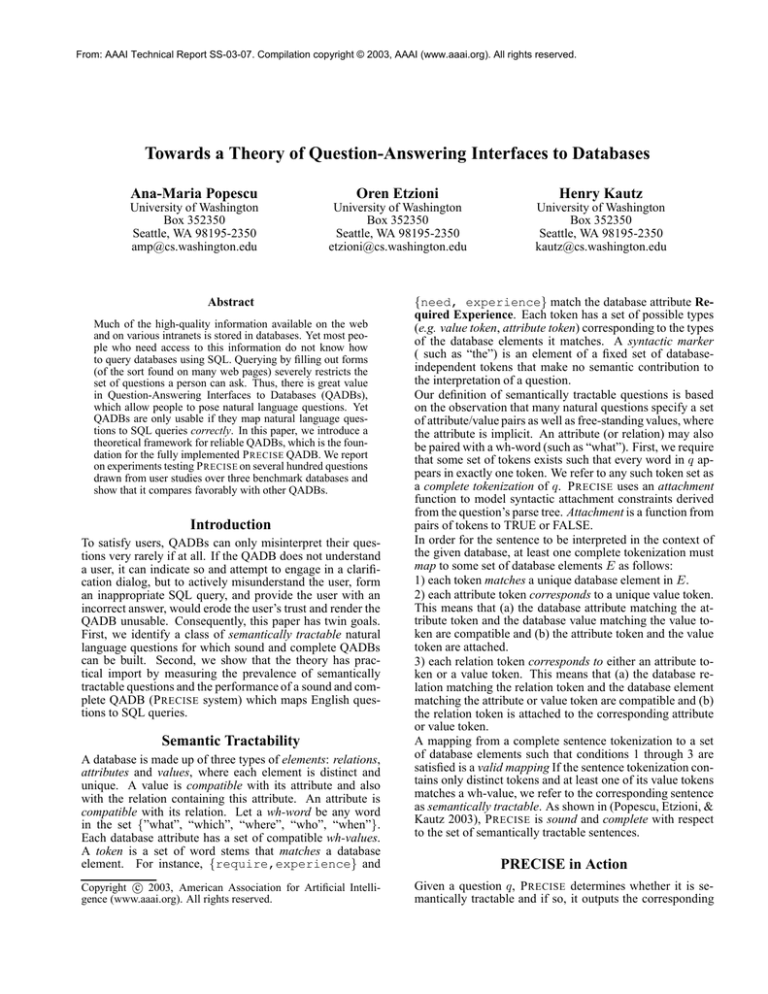
From: AAAI Technical Report SS-03-07. Compilation copyright © 2003, AAAI (www.aaai.org). All rights reserved.
Towards a Theory of Question-Answering Interfaces to Databases
Ana-Maria Popescu
Oren Etzioni
Henry Kautz
University of Washington
Box 352350
Seattle, WA 98195-2350
amp@cs.washington.edu
University of Washington
Box 352350
Seattle, WA 98195-2350
etzioni@cs.washington.edu
University of Washington
Box 352350
Seattle, WA 98195-2350
kautz@cs.washington.edu
Abstract
Much of the high-quality information available on the web
and on various intranets is stored in databases. Yet most people who need access to this information do not know how
to query databases using SQL. Querying by filling out forms
(of the sort found on many web pages) severely restricts the
set of questions a person can ask. Thus, there is great value
in Question-Answering Interfaces to Databases (QADBs),
which allow people to pose natural language questions. Yet
QADBs are only usable if they map natural language questions to SQL queries correctly. In this paper, we introduce a
theoretical framework for reliable QADBs, which is the foundation for the fully implemented P RECISE QADB. We report
on experiments testing P RECISE on several hundred questions
drawn from user studies over three benchmark databases and
show that it compares favorably with other QADBs.
Introduction
To satisfy users, QADBs can only misinterpret their questions very rarely if at all. If the QADB does not understand
a user, it can indicate so and attempt to engage in a clarification dialog, but to actively misunderstand the user, form
an inappropriate SQL query, and provide the user with an
incorrect answer, would erode the user’s trust and render the
QADB unusable. Consequently, this paper has twin goals.
First, we identify a class of semantically tractable natural
language questions for which sound and complete QADBs
can be built. Second, we show that the theory has practical import by measuring the prevalence of semantically
tractable questions and the performance of a sound and complete QADB (P RECISE system) which maps English questions to SQL queries.
Semantic Tractability
A database is made up of three types of elements: relations,
attributes and values, where each element is distinct and
unique. A value is compatible with its attribute and also
with the relation containing this attribute. An attribute is
compatible with its relation. Let a wh-word be any word
in the set {”what”, “which”, “where”, “who”, “when”}.
Each database attribute has a set of compatible wh-values.
A token is a set of word stems that matches a database
element. For instance, {require,experience} and
c 2003, American Association for Artificial IntelliCopyright gence (www.aaai.org). All rights reserved.
{need, experience} match the database attribute Required Experience. Each token has a set of possible types
(e.g. value token, attribute token) corresponding to the types
of the database elements it matches. A syntactic marker
( such as “the”) is an element of a fixed set of databaseindependent tokens that make no semantic contribution to
the interpretation of a question.
Our definition of semantically tractable questions is based
on the observation that many natural questions specify a set
of attribute/value pairs as well as free-standing values, where
the attribute is implicit. An attribute (or relation) may also
be paired with a wh-word (such as “what”). First, we require
that some set of tokens exists such that every word in q appears in exactly one token. We refer to any such token set as
a complete tokenization of q. P RECISE uses an attachment
function to model syntactic attachment constraints derived
from the question’s parse tree. Attachment is a function from
pairs of tokens to TRUE or FALSE.
In order for the sentence to be interpreted in the context of
the given database, at least one complete tokenization must
map to some set of database elements E as follows:
1) each token matches a unique database element in E.
2) each attribute token corresponds to a unique value token.
This means that (a) the database attribute matching the attribute token and the database value matching the value token are compatible and (b) the attribute token and the value
token are attached.
3) each relation token corresponds to either an attribute token or a value token. This means that (a) the database relation matching the relation token and the database element
matching the attribute or value token are compatible and (b)
the relation token is attached to the corresponding attribute
or value token.
A mapping from a complete sentence tokenization to a set
of database elements such that conditions 1 through 3 are
satisfied is a valid mapping If the sentence tokenization contains only distinct tokens and at least one of its value tokens
matches a wh-value, we refer to the corresponding sentence
as semantically tractable. As shown in (Popescu, Etzioni, &
Kautz 2003), P RECISE is sound and complete with respect
to the set of semantically tractable sentences.
PRECISE in Action
Given a question q, P RECISE determines whether it is semantically tractable and if so, it outputs the corresponding
SYNTACTIC MARKERS
TOKENS
are the on a
job
LEXICON
JOB
system
HP
Unix
what
Description
Developer System Admin
what
Platform
HP
what
Company
Stratify
Unix
HP
what
SQL QUERY
SELECT DISTINCT Description FROM JOB WHERE Company = ’ HP ’ AND Platform = ’Unix ’;
Figure 1: The transformation of the question “What are the
HP jobs on a Unix system?” to an SQL query, in the context
of a database containing a single relation, JOB, with attributes
Description, Platform and Company.
SQL query (queries)1. To illustrate P RECISE’s behavior consider how it maps the example question “What are the HP
jobs on a Unix system?” to an SQL query. For brevity and
clarity, this example refers to a single relation (Job) with
attributes Description, Platform and Company.
The tokenizer strips syntactic markers and produces a single complete tokenization of this question: (what, HP,
job, Unix, system). By looking up the tokens in the
lexicon (which also contains synonym information), PRE CISE retrieves the set of matching database elements for every token. In this case, what, HP and Unix are value tokens, system is an attribute token and job is a relation
token (see Figure 1).
The problem of finding a mapping from a complete tokenization of q to a set of database elements such that the
semantic constraints imposed by conditions 1 through 3 are
satisfied is reduced to a graph matching problem. P RECISE
uses the max-flow algorithm to efficiently solve this problem. After all attribute and value tokens have been matched
to database elements, P RECISE ensures that all relation tokens correspond to either a value token or an attribute token
that the match satisfies the syntactic constraints represented
by pairs of attached tokens:(what, job),(HP, job),
(Unix, system). If all the attachment constraints are
satisfied it means that a valid mapping has been found. Each
valid mapping is converted into a SQL query; in the end
P RECISE will return the set of non-equivalent such queries.
In our example, a single valid mapping is found and so the
P RECISE returns the SQL query at the bottom of Figure 1.
Experimental Evaluation
We ran our experiments on three benchmark databases in the
domains of restaurants, jobs, and geography. Each database
was tested on a set of several hundred English questions
whose corresponding SQL query was manually generated
by an expert (Tang & Mooney 2001).
We detected whether a question was “semantically
tractable” by running P RECISE on the question, if P RECISE
generated one or more answers for the question then we
knew that the question is semantically tractable. Our first
experiment showed that semantically tractable questions are
1
P RECISE
can
be
http://www.cs.washington.edu/research/nli
accessed
at
quite common : 77.5% in the geography database, 88% in
the jobs database, 97% in the restaurant database. Our second experiment compared P RECISE’s accuracy with that of
Mooney’s learning QADB and with Microsoft’s QADB for
SQL server (“English Query”). Formally, the precision of
an QADB on a data set is defined as the number of English
questions where the QADB correctly maps a question to the
corresponding SQL query, divided by the number of questions that the QADB answers (each QADB declines to answer some questions). We found that on each of our benchmark databases, P RECISE made no mistakes (see Figure 2).
Precise shows better precision than the learning QADB and
massively outperforms Microsoft’s product on each of the
databases tested.
Precision (Mooney Data)
What are the HP jobs on a Unix system?
100
90
80
70
60
50
40
Rest
Geo
Mooney
Precise
EQ
Jobs
Figure 2: Precision on Mooney’s Data: P RECISE makes no errors on semantically tractable sentences.
All the QADBs tested in our experiments decline to answer
some questions. We refer to the number of questions answered by an QADB, divided by the total number of questions as that QADB’s recall. The recall for the different
QADBs is shown in Figure 3. We see that P RECISE ’ S recall compares favorably with that of the other two QADBs.
100
90
Recall(Mooney Data)
QUESTION
80
70
60
50
40
30
Rest
Geo
Mooney
!!!!
Precise
EQ
Jobs
Figure 3: Recall on Mooney’s Data: P RECISE handles slightly
fewer questions than Mooney’s learning QADB, but more questions than Microsoft’s English Query.
Conclusions and Future Work
We have described a novel theoretical and practical approach
to the problem of producing a reliable QADB. Although
P RECISE is only effective on semantically tractable questions, in future work we plan to explore increasingly broad
classes of questions both experimentally and analytically.
References
Popescu, A.; Etzioni, O.; and Kautz, H. 2003. Towards a theory
of natural language interfaces to databases. In Proceedings of
IUI-2003.
Tang, L., and Mooney, R. 2001. Using Multiple Clause Constructors in Inductive Logic Programming for Semantic Parsing. In
Proceedings of the 12th European Conference on Machine Learning (ECML-2001), Freiburg, Germany, 466–477.







